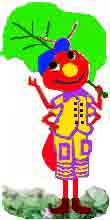|
ОСНОВНАЯ ЛИТЕРАТУРА
по систематике Formicinae
|
-
Длусский Г.М., Федосеева Е.Б. (1988) Происхождение и ранние этапы эволюции муравьёв. // Меловой и биоценотический кризис и эволюция насекомых. М.:Наука, 1988. - Стр.70-144.
-
Agosti, D. (1991). Revision of the oriental ant genus Cladomyrma, with an outline of the higher classification of the Formicinae (Hymenoptera: Formicidae). Systematic Entomology 16:293-310.
pdf-КОПИЯ СТАТЬИ
-
Agosti, D. (1992). "Revision of the ant genus Myrmoteras of the Malay Archipelago (Hymenoptera, Formicidae)." Rev. Suisse Zool. 99: 405-429.
Описано 13 новых видов Myrmoteras из Малайского архипелага.
pdf-КОПИЯ СТАТЬИ
-
Agosti, D. (1994). "A new inquiline ant (Hymenoptera: Formicidae) in Cataglyphis and its phylogenetic relationship." J. Nat. Hist. 28: 913-919.
pdf-КОПИЯ СТАТЬИ
-
Agosti, D. (1994). The phylogeny of the ant tribe Formicini (Hymenoptera: Formicidae) with the description of a new genus. Systematic Entomology 19:93-117.
Ревизия голарктической трибы Formicini, описан новый род Bajcaridris. Подрод Iberoformica синонимизирован с Formica. Филогения, синопсис, диагноз и определители родов.
pdf-КОПИЯ СТАТЬИ
-
Blum, M. S., T. H. Jones, W. L. Overal, H. M. Fales, J. O. Schmidt y N. A. Blum. 1983. Exocrine chemistry of the monotipic ant genus Gigantiops. Comparative Biochemistry and Physiology 57B(1):15-16.
-
Bolton, B. (1994). Identification guide to the ant genera of the World. 222 pp. Harvard University Press, Cambridge.
-
Bolton, B. (1995). A taxonomic and zoogeographical census of the extant ant taxa (Hymenoptera: Formicidae). Journal of Natural History 29:1037-1056.
-
Bolton, B. (2003). Synopsis and Classification of Formicidae. 370 pp. Memoirs of the American Entomological Institute, Vol. 71. Gainesville, FL.
-
Brady, S. G., J. Gadau y P. S. Ward. (2000). Systematics of the ant genus Camponotus (Hymenoptera: Formicidae): a preliminary analysis using data from the mitochondrial gene cytochrome Oxidase I, pp. 131-139 in A. D. Austin and M. Dowton, eds., Hymenoptera: Evolution, Biodiversity and Biological Control. CSIRO Pub., Australia.
-
Brown, W. L. Jr. (1955). A revision of the Australian ant genus Notoncus Emery, with notes on the other genera of Melophorini. Bulletin of the Museum of Comparative Zoology 113(6):471-494 .
-
Fernandez, F. (2002). Revision de las hormigas Camponotus del subgenero Dendromyrmex (Hymenoptera:
Formicidae). Papeis Avulsos de Zoologia (Sгo Paulo) 42(4):47-101.
-
Hashmi, A. A. (1973). A revision of the Neotropical ant subgenus Myrmothrix of genus Camponotus. Studia Entomologica (N.S.) 16:1-140.
-
Johnson R.A.y P.S. Ward. 2002. Biogeography and endemism of ants (Hymenoptera: Formicidae) in Baja California, Mйxico: a first overview. Journal of Biogeography 29:1009-1026.
-
Kempf, W. W. (1972). Catalogo abreviado das formigas da Regino Neotropical. Studia Entomologica (N.S.) 15:3-344.
-
Kempf, W. W. y K. Lenko. (1968). Novas observaсoes e estudos sуbre Gigantiops destructor (Fabricius) (Hymenoptera: Formicidae). Papeis Avulsos de Zoologia 21(22):209-230.
-
Kusnezov, N. (1978). Hormigas Argentinas: Claves para su identificacion. Inst. Miguel Lillo Misc., Tucuman.
-
MacKay, W. P. (1997). A revision of the Neotropical ants of the genus Camponotus, subgenus Myrmostenus (Hymenoptera: Formicidae). Proceedings of the Entomological Society of Washington 99(1):194-203.
-
MacKay, W. P. y E. MacKay. (1997). A revision of the Neotropical ants of the montivagus species complex, genus Camponotus, subgenus Myrmentoma (Hymenoptera: Formicidae). Sociobiology 30(3):319-
334.
-
Rojas-Fernandez, P. 1996. Formicidae (Hymenoptera), pp. 483-500 en J. Llorente, A. N. Garcia y E. Gonzalez, eds., Biodiversidad, taxonomia y biogeografia de artropodos de Mexico: hacia una sintesis de su conocimiento. Universidad Nacional Autonoma de Mexico.
-
Santschi, F. 1923. Revue des fourmis du genre “Brachymyrmex” Mayr. Anales del Museo Nacional
de Historia Natural de Buenos Aires 31:650-678.
Shattuck, S. O. (1992). "Higher classification of the ant subfamilies Aneuretinae, Dolichoderinae and Formicinae (Hymenoptera: Formicidae)." Syst. Entomol. 17: 199-206.
Анализ филогении, морфологии и высшей классификации Aneuretinae, Dolichoderinae и Formicinae показал их монофилию и то, что подсемейства Dolichoderinae и Formicinae являются сестринскими группами. Этот результат отличается от большинства предыдущих выводов, когда сестринскими считались Aneuretinae и Dolichoderinae.
Trager, J. P. 1984. A revision of the genus Paratrechina (Hymenoptera: Formicidae) of the Continental United States. Sociobiology 9(2):51-162.
Weber, N. A. 1944. The Neotropical coccid-tending ants of the genus Acropyga Roger. Annals of the
Entomological Society of America 37:89-122.
Wheeler, G. C. (1921). The larvae of the subfamilies Dolichoderinae and Formicinae, S.D. dissert., Harvard University.
Wheeler, W. M. 1934. Neotropical ants collected by Dr.Elisabeth Skwarra and others. Bulletin of the Museum
of Comparative Zoology 77(5):157-240.
Wheeler, W. M. 1935. Ants of the genus Acropyga Roger, with description of a new species. Journal of the New York Entomological Society 63:321-329.
Zenner, I. 1990. Biological aspects of the “hormiga loca” Paratrechina fulva (Mayr) in Colombia, pp. 291-297 in R. K. van der Meer, K. Jaffй and A. Cedeсo, eds., Applied Myrmecology: A world perspective. Westview Press, Boulder.
|

